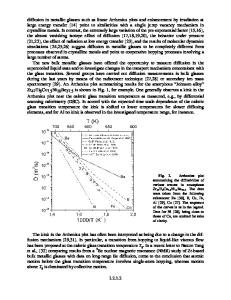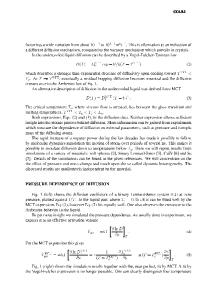Liquid-Liquid Phase Separation of Melts and Glasses in Ferric Ferrous Oxide-Silica System
- PDF / 397,510 Bytes
- 6 Pages / 414.72 x 648 pts Page_size
- 19 Downloads / 326 Views
and advanced magnetic materials having single domain. Especially, when phase separated glasses are prepared from liquid-liquid immiscible melts under micro gravity condition and by subsequent operations such as elongation or compression, the glassy materials containing genuine spherical particles or regularly deformed ones will be obtained without segregation of component due to the difference of specific gravity. The former material will become a micro cavity laser device and the later one will appear anisotropical properties.[4, 5] There are many binary silicate systems having liquid-liquid miscibility gap such as alkaline earth-silica and zinc oxide-silica systems. Ferric ferrous oxide-silica system also has widespread liquid-liquid miscibility gap as shown in Fig. 1.[6, 7, 8] In high silica composition of this system, FeO.Fe2 O3-rich particles will be there in SiO 2-rich glass matrix and this phase separated materials are hopeful as the base of the new functional materials showing highly optical, magnetic, and magneto-optical properties. However, its miscibility gap and the tie line in high temperature region, and the morphology of the glassy materials has not been investigated yet. Furthermore, Fe-rich phase may segregate from Si0 2-rich matrix during melting under terrestrial gravity due to the difference of their specific gravity. In this study, the melts and their quenched glassy materials of ferric ferrous oxide-silica system in miscibility gap were prepared. The morphology of phase separated structure and fluctuations of the compositions were investigated in order to obtain the behavior of phase separation in this system for further experiment under micro gravity. 459 Mat. Res. Soc. Symp. Proc. Vol. 455 © 1997 Materials Research Society
2400
2400
C:Cristobaraite T:Tridymite
.U 2200
j.,2.2200
Si Oz
a)
-3 2000
i
Q) 1800 •2L
E •. 1600r
C+L FeO
1400 50
FeO
70 90 mol% SiC2
Fe3 0 4 Fe 2 0 3 M:Magnetite 50
m
Fe 3 0 4
M+T; 70 90
mol%
,,2000 !
:
4-J
1800 (U E
1600 1400 SiOz
Figure 1 Phase Diagram of Ferric Ferrous Oxide-Silica System. [1,2,3] EXPERIMENT Reagent grade a-quartz (Si0 2) and magnetite (Fe 3 0 4 ) fine powder in the composition of 5 Fe 30 4-95 SiC 2 and 15 Fe 30 4-85 Si0 2 (mol%) were mixed and calcined at 1350°C for 24 h in vacuo (d10 2 torr). Calcined powder was molded into rod shape by use of a cold isostatic press (98 MPa). The rod samples were sintered at 1350°C for 24 h in vacuo. The sintered rods were melted at 2300°C or 22000C under Ar gas atmosphere by use of an infrared image furnace with 5.4 kW Xe lamp (Nichiden Machinery, FQ-50XS) in order to obtain a homogeneous single liquid phase. Subsequently, the melts were cooled to 1800°C or 1750'C and were held there for Sintered rod promoting phase separation. Finally, the melts N /Infrared ray were quenched by moving them from the focal point of the image furnace. The temperature of Melting drop the melting drop was measured by use of the radiation pyrometer with 5 jirm infrared ray (Japan Sensor, TSS-15G ) from the bottom
Data Loading...











